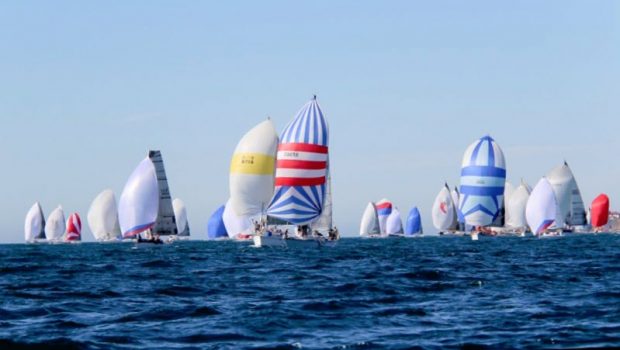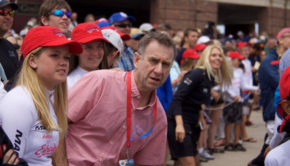A Conversation about Competition
Published on February 12th, 2018
by Craig Leweck, Scuttlebutt
Sailing is that sport when, if you seek it out, you can compete against the best in the game. No other sport provides access to its elite athletes. There are amateur sailors that thrive on this, whereas others may like the idea at first, but soon find that getting hopelessly pummeled is no way to spend their recreational hours.
Heightened competition requires increased commitment in time and money. As a result, that level of play will appeal to fewer people. But what creates heightened competition? Certain classes have the history, such as the Star and Etchells, whereas newer high performance classes tend to attract the best sailors.
While there are exceptions, the general landscape in sailing is demanding more effort. The overall complexity has risen, whether it is in equipment or preparation. Costs keep increasing, so how do you hold down the bar to ensure you maximize participation? Here are three variables to consider:
• Culture: Managing the arms race through cooperation is powerful and healthy. As most people compete within established fleets in their local area, a strong social program can hold back the overzealous. Once a vibe is established, senior fleet members can educate new comers on what is expected.
• Format: The regatta trend toward more races a day and W/L courses does not create growth as both require more skill. Best sailors tend to win regardless of event format, but more people can feel competent when the daily schedule and technique required are minimized. Alternative courses and a race schedule that leaves energy for après sailing assures wider support.
• Sailor Classification: When all else fails, make rules. While boats have rules that define their one design status or derive their handicap rating, the unmeasured variable is onboard expertise. Two identical boats are not identical if one is sailed by weekend warriors and the other has America’s Cup veterans.
To provide events and classes with an international system for assessing expertise, the Sailor Classification Code was launched as a universal approach that provides a distinction between sailors who race only as a pastime (Group 1 – amateur) and sailors with a financial interest in the sport (Group 3 – professional).
The system took great pains to identify those marine industry professionals who were tilting the playing field, and while this wasn’t a perfect way to identify expertise, if the system was used it did theoretically control the influence of people whose income was connected to race outcome.
But the shortcoming in the system is how it assumes all Group 3 sailors have the same expertise, and it has become increasingly less perfect with the increase of Group 3 sailors who are not employed in the marine industry but rather derive their income from skippers willing to pay for their crewing services.
This influx of paid crew has created a new sector that arguably has the most expertise. Whereas before, for example, sailmakers often had the most expertise, now there are very few industry pros that are better than the paid crew, and there are possibly no industry pros that can win certain world championships (Etchells, Melges 20, J/70, etc) as skipper.
The debate now is if there needs to be three categories: Group 1 (amateur), Group 2 (paid sailor), and Group 3 (employed marine industry). This would allow flexibility in how the system was used, and if the interest was to limit the participation of Group 2 sailors, that would still allow Group 3 sailors such as boat brokers, riggers, journalists, etc from competing.
Here are examples of how classes or events are utilizing the current Sailor Classification Code:
———————
No paid crew
In the Viper 640 class, they do not limit participation of Group 3 sailors but no helmsperson or crew member may be “paid” to sail in any race aboard a boat. The class culture makes this rule work.
Defining permitted Group 3 participants
In the J/111 class, with the exception of one crew member, all those under the age of 65 shall hold a valid Group 1 classification. As an exemption, for events not initiated and controlled by the J/111 Class association or class fleet, one additional member of crew may be a Group 3 or unclassified competitor who is a full time employee of J/Boats or of a J/Boats approved dealer, or is the J/111 class manager
Flexibility in controlling Group 3 participation
The J/105 class provides three options:
Level A: The crew aboard (excluding a 100% Owner) shall be comprised of Group 1 competitors.
Level B: The crew aboard (including a 100% Owner) shall be comprised of Group 1 competitors, except that the crew may include one Group 3 competitor.
Level C: OPEN – The crew aboard (excluding Owner) may consist of any combination of Group 1 and 3 competitors.
If no Level is designated by the Notice of Race or by other Class notice 45 days prior to the event, then Level A shall apply.
No limitations on Group 3 participants
A class takes this approach when there either hasn’t been a problem, such as older, established one designs (ie, Lightning, Thistle, etc) or newer classes that are eager for the support that Group 3 sailors provide. Also, any limitations require a level of governance that can create conflict.
Limitations on number of Group 3 participants
For example, in Farr 40 One Design Class events, “the crew including skipper, and owner(s), if aboard, shall be composed of Group 1, (Amateur), competitors except that not more than four crew members may be other than Group 1.”
Corinthian division
For a class that does not limit eligibility of participant based on their classification, a Corinthian sub-division provides recognition for teams entirely comprised of Group 1 sailors. However, this infers those teams not eligible for the Corinthian class have paid crew, when in fact they may just have as crew someone snared by the Classification Code that holds no exceptional expertise.
Corinthian event
For a class that does not limit eligibility of participant based on their classification, a Corinthian event provides competition for teams entirely comprised of group one sailors.
———————
If the impact of professionalism has not reached your sailing fleet, know that the genie is out of the bottle and I don’t see it going back in. My suggestion is to beef up your culture and review your event formats, and if needed, tighten your rules. Change is far harder after a problem is recognized. Avoid attrition before it occurs.









 We’ll keep your information safe.
We’ll keep your information safe.